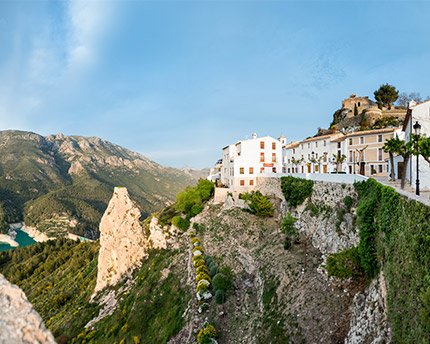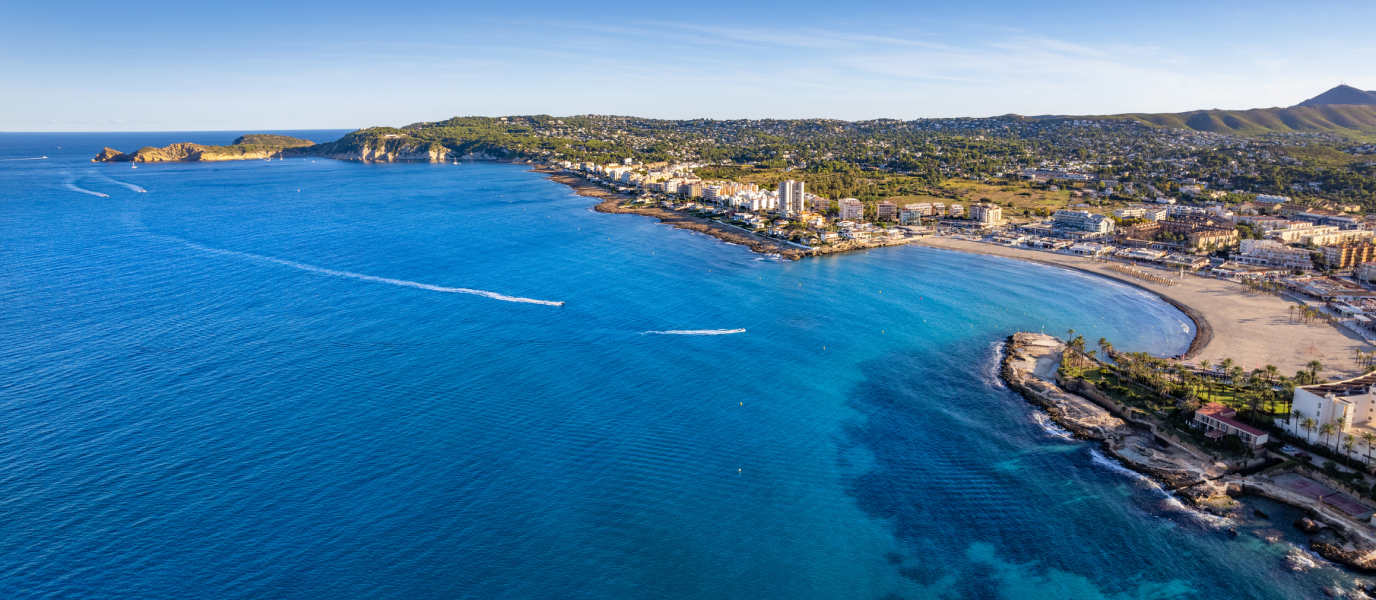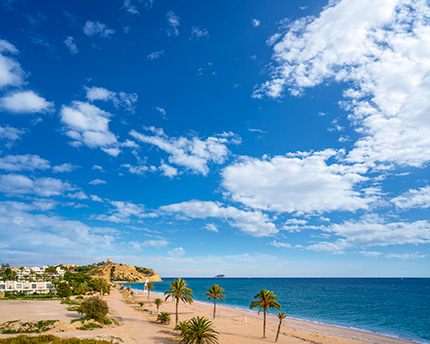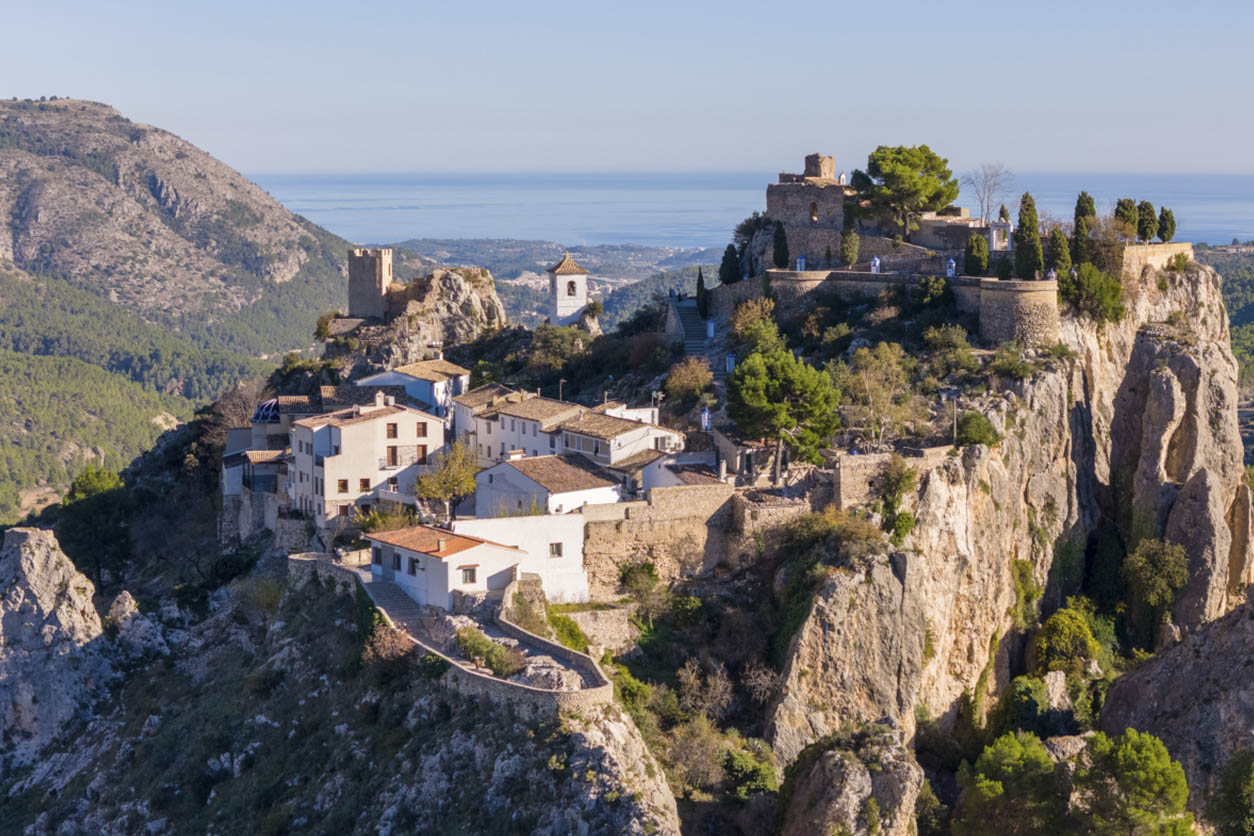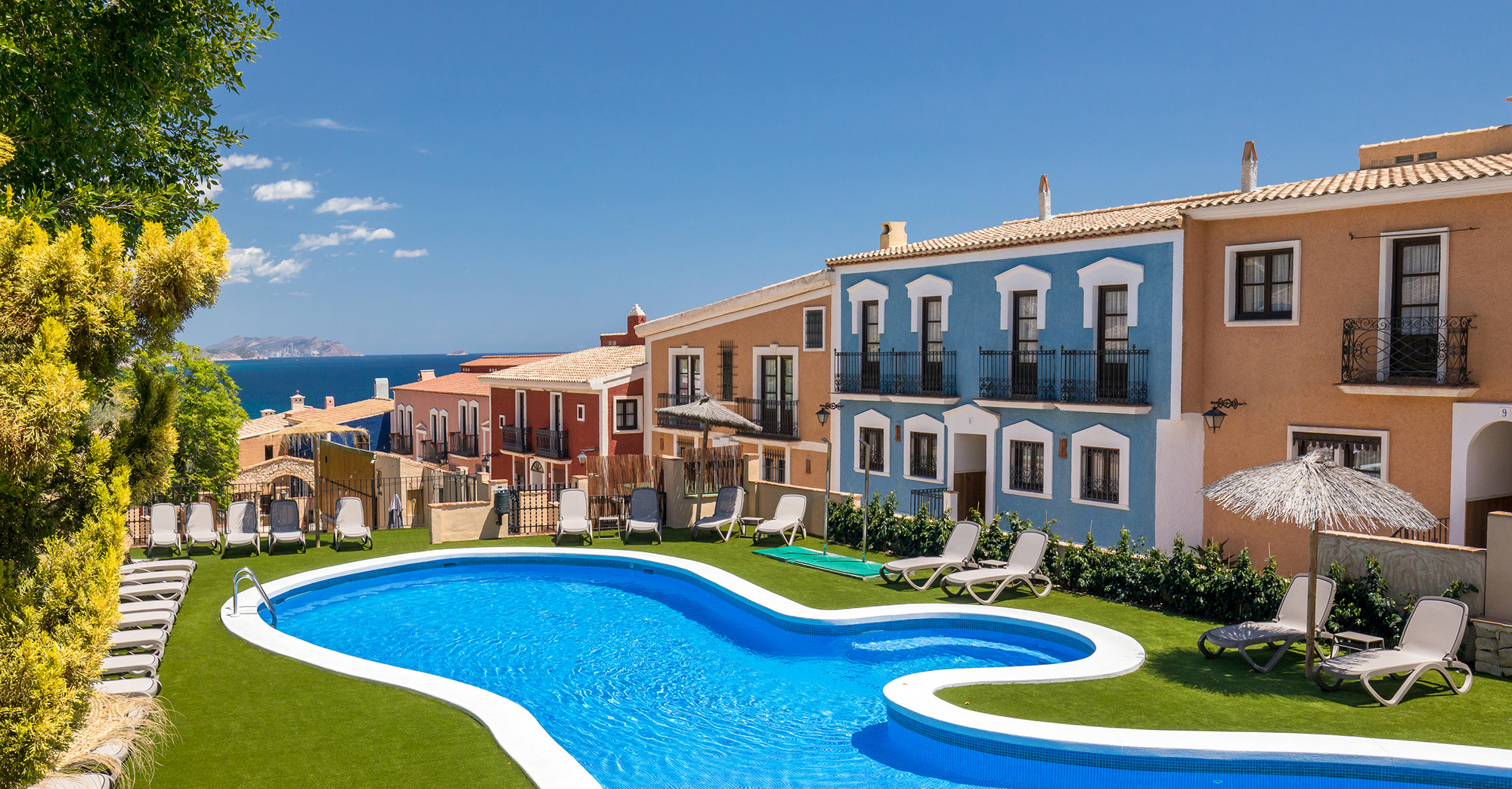The Baetic Mountains, which cross the southeastern part of the Iberian Peninsula, break before they come to the sea of Alicante, forming abrupt peaks and cliffs. In the area, around 24 kilometres from Benidorm and the coast, hidden amid the mountain ranges of Xorta, Serrella, Aitana and Bernia, the village of Castell de Guadalest (as it is known in Valencian, or just Guadalest, as it is referred to in Spanish) dominates the green valley of Guadalest, whose almond, orange and olive groves adorn the hillside terraces. The rock’s vertical walls, which shield the village, are truly monumental, especially when you take into account the flatness of the province of Alicante.
Many of the villages in the Valley of Guadalest have Arab origins, since it once marked the boundary of the ancient Almohad Caliphate, before it eventually collapsed. The valley was hard to access, a haven of vegetation concealed amid the mountains that was nevertheless perfect for defensive purposes. At the time, the village of Castell de Guadalest, which sits on a crag at a height of around 600 metres, loomed over the valley with its hanging castles. There was only one way to access the medieval village: through a tunnel bored through the upper part of the rocky elevation.
Such is Castell de Guadalest’s magical charm that it has been recognised with various titles: a Historical and Artistic Site, a Cultural Heritage Site and, more recently, the honour of forming part of the association of ‘The Most Beautiful Villages in Spain’.
The picturesque village of Castell de Guadalest
The village of Castell de Guadalest is principally divided into two neighbourhoods: the ancient medieval area, accessible only via an elevated tunnel through the rock, and the Arrabal. The latter was created at a subsequent date and sits on the hillside. It offers a wide range of options for tourists, who have not been able to resist the place since the seventies.
When strolling through its streets adorned with white houses, geraniums, palm trees and colourful flower pots, you’ll come across a large number of craft shops selling items made from the area’s traditional materials, such as leather and wicker. You won’t fail to notice that the village is a natural viewpoint: elevated above the rock as it is, the village overlooks the valley, the turquoise Guadalest reservoir and the surrounding mountains. Wherever you are in the village you’ll find spectacular views, which is why certain spots have been designated ‘official’ viewpoints, such as those of Penya del Cullerot and Guadalest reservoir and the Plaza San Gregorio viewpoint.
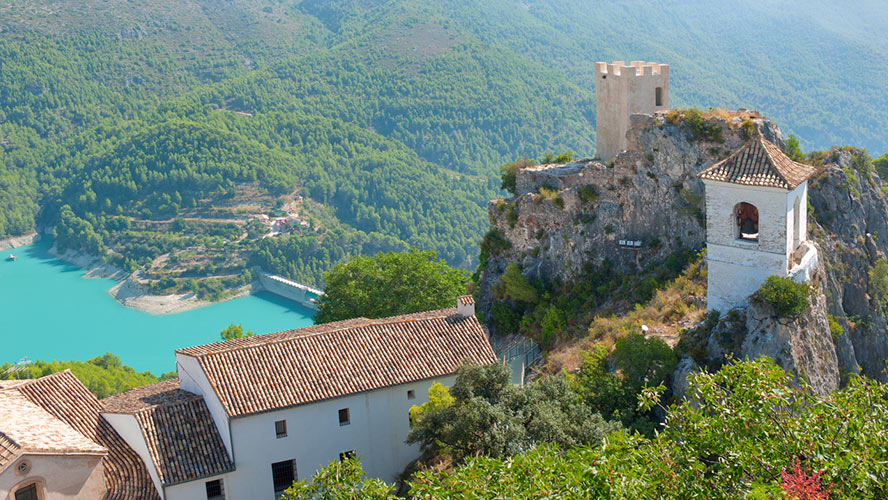
The fortresses of the Valley of Guadalest: San José Castle and Alcozaiba Castle
Two castles, both dating from the eleventh century and with Arab origins, have come to define Castell de Guadalest in a land as dangerous as it was on the border with the Christian Kingdom. Of San José Castle, also known as the Hanging Castle of Guadalest, all that remains is the keep (the main and most raised part of the castle where its master lived) and sections of the walls. This is due to two series of earthquakes that devastated the area in the year 1644 and subsequently in the years 1748 and 1752. Later on, during the War of the Spanish Succession, a large part of the castle was sadly blown up.
Overlooking the village its figure evokes the medieval spirit in which it was built and has all the safety of an inaccessible stronghold perfectly adapted to its surroundings. The same is true of La Alcozaiba castle or fortress – situated on the land of Casa Orduña – of which all that remains is a tower. Unassailable, it stands tall above the rocky crag accompanied by a single white bell tower, which greets you from upon high as you enter the ancient village.
The Micro-Miniature Museum and many others in Castell de Guadalest
It’s no wonder that Castell de Guadalest is known for its museums. Perhaps its most famous are those displaying works in miniature, but it doesn’t stop there: no less than nine museums are situated in the village’s main tourist area, meaning there is something for everyone out there. Below is a rundown of all the museums that you can visit:
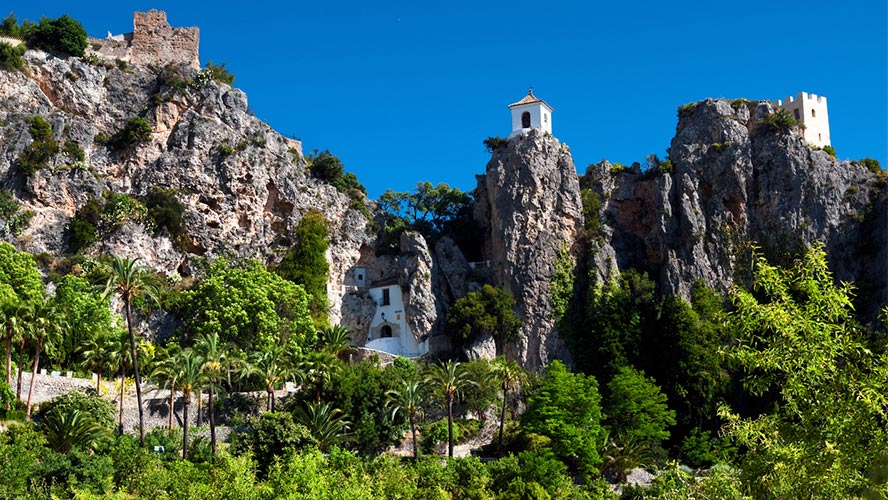
- Micro-Miniature Museum. The Statue of Liberty in the eye of a needle and Goya’s The Second of May 1808 on a grain of rice. All this and more can be seen at this museum, through strong lenses naturally.
- Micro-Gigantic Museum. Created by the artist Manuel Ussá, his many miniature pieces include the bible written on a strand of hair and a dressed-up flea riding a bike.
- Ethnological Museum. Presenting the life of Castell de Guadalest’s inhabitants between the sixteenth and twentieth centuries, this museum is housed in a typical eighteenth-century home dug out from the rock and boasts domestic and farm tools as well as weapons from the time.
- Antonio Marco Museum. Here you can find a miniature model of Bethlehem and various other model buildings, as well as old toys.
- Museum of Torture or Historical Medieval Museum. In this unnerving place you can discover more than 70 pieces or instruments that were used for execution or torture.
- Guadalest Valley Museum of Historical Vehicles. Housing over 140 motorbikes and small cars from the twenties through to the seventies, this museum also boasts other objects from the time including sewing machines, typewriters, telephones, radios and much more.
- Ribera Girona Museum. This museum is part of Guadalest Castle and displays work by contemporary artists.
- Guadalest Salt and Pepper Shaker Museum. Boasting approximately 20,000 salt and pepper shakers from all over the world, the oldest of which date back to the early nineteenth century. There is only one other museum of its kind located in the United States.
- Casa Orduña Municipal Museum. Casa Orduña, which dates from 1644, was built by the Basque family of the same name. For 300 years they ruled the fortress. In it you can find paintings, images, reception rooms with furniture from the time, a kitchen with a ceramics display and other rooms with exquisite furniture.
More places to visit in Castell de Guadalest
If you have a bit of a extra time on your visit you can always head to the twelfth-century prison of Guadalest Castle. This vaulted dungeon, situated in the cellar of the Town Hall, still has the power to frighten visitors, buried deep below its solid walls. Nuestra Señora de la Asunción Parish Church, on the other hand, is a good alternative to the dark jail and its tiny little windows. Built in Baroque style in the eighteenth century, it was constructed on the site of a thirteenth-century temple, built after the Christian conquest of the island.
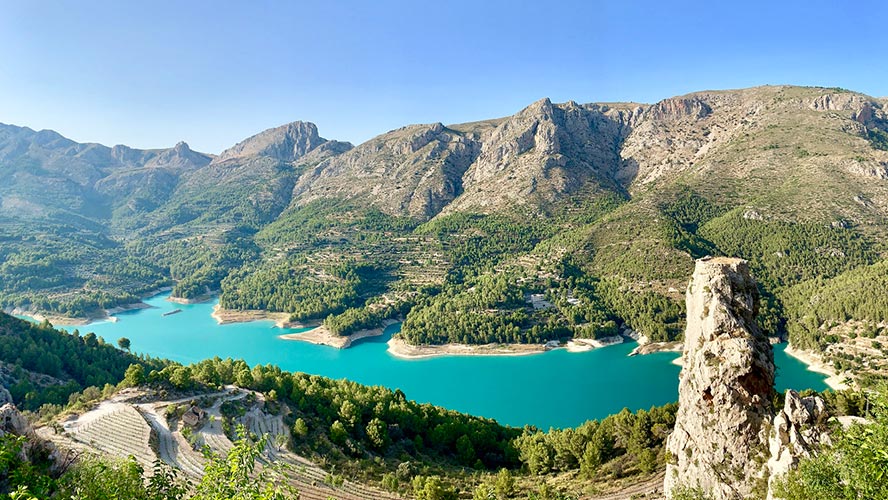
Finally, there are numerous hiking routes to be enjoyed around the colourful hillsides of the mountain range surrounding Castell de Guadalest. One of the most famous is the one leading to Guadalest reservoir, where many people head to sunbathe on the banks of the emerald-coloured expanse of water. Meadows full of flowers, pine trees and varied vegetation combine with activities such as kayaking routes in one of the prettiest natural spaces in Alicante.




































































